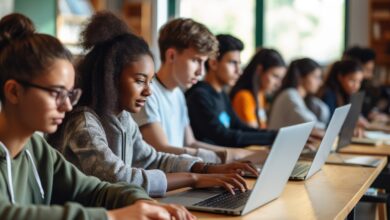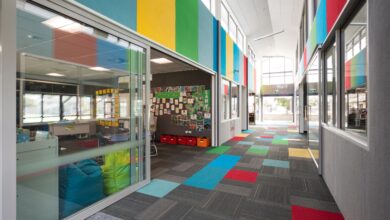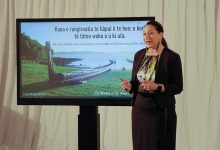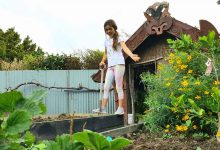Thinking differently: distance learning in senior primary
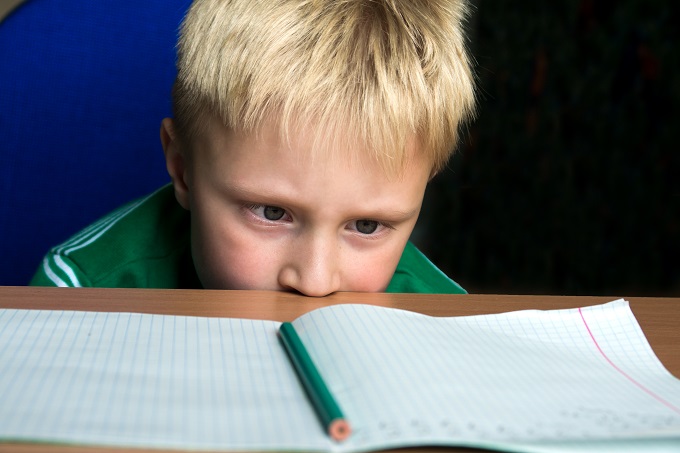
A joint blog by Greg Carroll and Mark Maddren.
This blog post offers some key considerations for setting up programmes in ways that will cater for senior primary rangatahi as they learn from home. We hope that applying them will help you to ensure that your ‘Learning at Home’ programme is successful.
1. Preserving and adapting
First up, what do you already do well? Start by thinking about the many current strengths of your kura or school and classroom-based programmes. Which of these remain essential, and what adjustments might you need to make to ensure these continue to work effectively in an online environment? A Universal Design for Learning (UDL) approach is useful here. For example, in your face to face teaching, you will probably offer specific supports or approaches to some students such as text-to-speech, or breaking tasks into smaller parts, or supporting instructions with visuals. Now you are working online, take a universal approach and offer these supports to everyone, build them into the design of the activity from the outset.
2. Supporting your people
Whakawhanaungatanga (connecting through building relationships) is important in the move to online spaces and blended ways of working. These spaces can be socially isolating unless you build in times and opportunities for people to connect naturally, in human ways, with each other. Just chatting and catching up is an excellent way to begin online sessions. You could start with a fun activity and go “around the room” if the gathering is kaiako, rangatahi or whānau.
How might you support those ākonga who find it difficult to access online opportunities like webinars because they have childcare responsibilities, or are working on shared devices? What if whānau home circumstances mean connectivity is low or non-existent? Can you record webinars and share the recordings? Could you send school devices home? Could you make school data available to your community?
3. Involving whānau
You know your communities, and you want to guide families to support rangatahi in this new context. Helping everyone in the whānau to understand what you are doing and why is especially important for those who might assume the role of key learning support for their children. Ask them what they think they might need to get more involved. Give them a chance to ask you questions.
Could you run face to face or virtual training opportunities to get your community up to speed? What opportunities are there to connect virtually with them through a Google Hangout Meet (which can cater for up to 250 people) or Zoom meeting to help inform and upskill them? You could record this and publish it to the kura or school website, or Facebook page, or class Seesaw page.
Recently Gareth Taylor, the principal of Grants Braes School in Dunedin, ran drop-in book reading sessions for his school community. The engagement from everyone was huge, with up to 85 connections to a single session. He was able to use this time as families were moving into making sense of the lockdown situation to make strong connections into each home and to maintain the quality relationships with ākonga and whānau.
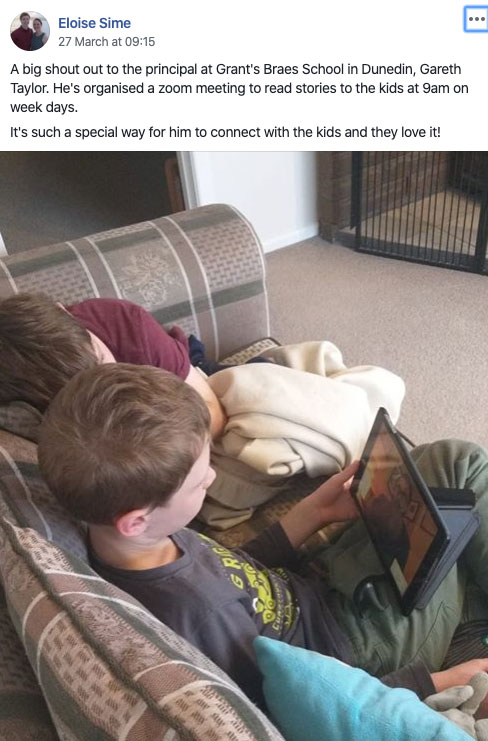
Republished via CORE Education with permission from Primary Teachers Facebook Page post
4. Keeping learning healthy
As you design a virtual home programme consider whether there is an appropriate balance of screen and non-screen time. On a typical ‘distance learning’ day we would not expect screen time to be anywhere near the same time as the length of a kura/school day. How long do you expect ākonga to focus on school tasks, and how long on simply being a member of their family, enjoying the time to play and join in with whānau activities?
Plan a range of offline activities where learners simply access instructions online. For example, an online instruction might ask them to read and respond to a shared text or book with classmates, while the actual task requires no online component. Physical activity or creative art tasks need no technology. Ākonga could show their understanding of ideas within, across, and beyond texts by reading and making a simple recipe and then making the food. Family can rate the task! Then ākonga could share the menu and the ratings with the kaiako each week as an ‘assessment’. An example of one school’s task list of these kinds of activities is here.
As a kaiako or leader, ensure that you are also thinking about your own and your colleagues’ wellbeing. Have clear and shared expectations about when you are available to learners and their whānau, what time you will spend on content creation and learning programmes, and when you are off-duty.
5. Knowing it will be different
You will do things in different ways. You won’t have your students ‘present’ with you for the full school day. You will take your literacy or numeracy groups in Zoom or Google Meet instead of in person. Rangatahi will work independently of teachers (or adults at home) for much of the time. Setting up tasks and projects that learners can delve into and out of, as their circumstances allow, will be essential. Homes will often be busy places now, and many senior primary children will have other tasks and responsibilities. How can you include these into what you are asking of your learners? Could they be doing things like cooking meals, cleaning, gardening and other ‘real-life’ chores?
Doing less “school work” does not mean ākonga are not learning, or that what they are doing is not valuable.
In this new world, consider how rangatahi will:
- ask for help
- indicate they don’t understand
- ask clarifying questions
- work with a buddy
- share their successes
- get some downtime, engage and ensure their particular learning needs or interests are met.
Teacher roles will be different. The familiar rhythm we are used to in a school day will change. Kaiako may well spend more time providing feedback on shared or collaborative documents, and online platforms. They will connect with individuals or groups less frequently. Assessment, and even simple things like checking on completion of tasks, will be different too.
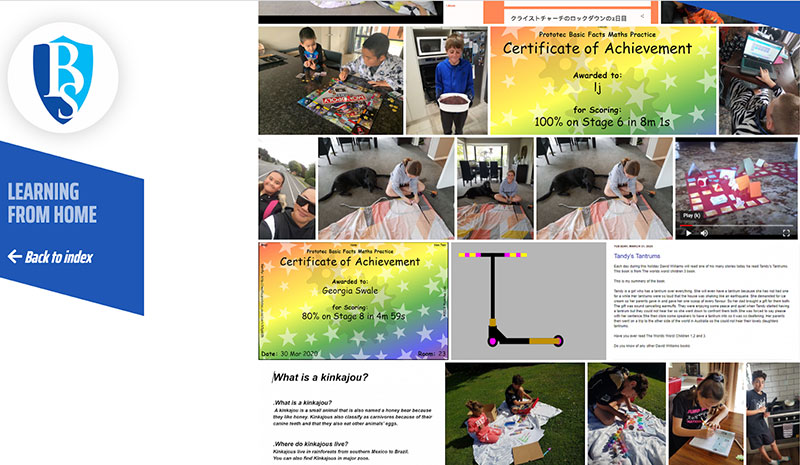
Belfast School in Christchurch understands things will be different. Even though they do not have all the answers, they have forged ahead with a plan to support their teams through Learning from Home.
For the last week of the term syndicates all posted a variety of home learning challenges, and even in the holiday break.
The principal, Sue Elley, invited parents to email in photos and brief explanations of the home learning tasks completed by each student. Initially intended just to connect home and school it quickly morphed into a more organised system. The school expects this sharing of learning experiences on the school Facebook page and the school Learning from Home website will encourage families to continue to engage with the online learning options.
Their intention was to support all teachers. This focus was crucial to the decisions leadership were making. Utilising the skills of staff and promoting collaboration, and ensuring equity and consistency in the Learning from Home resources for students, were both important. This emphasis also supported staff wellbeing while constructing and learning to use the different school sites.
Each syndicate had at least one staff member with a level of digital fluency who took responsibility for supporting their team to construct and manage their team Learning from Home site. They also oversaw uploading and managing the content in the site.
The wider team shared responsibility for being:
- Researchers who find sites, activities and content to upload.
- Quality checkers/scrutineers – checking that the content/activities are realistic for the level and ability of the students. In one case an activity was considered unsuitable because it involved building the highest tower using jubes and straws. Most homes now don’t have straws (ecological reasons), and in the current situation, families couldn’t pop down to the shop for a packet of jubes. Some whānau might also have objections for using food products in this way. Therefore the activity was deemed unsuitable for uploading.
The team leaders took an overview of their teams’ site and reflected on what is working and what might need changing. They drew on and analysed the examples of work the students were completing by looking at the Home Learning feature articles shared on Facebook and collated on the school website. These learnings about what was working was fed into their weekly online team meetings to support the decisions on what to add to the site in the future.
Using this blog post
We invite you to consider each section in this post with your team, or in your personal context. Where are the opportunities for you to adapt and change what you do to engage more fully with your community, and to make the distance learning programme as effective as it can be?
To recap, you could consider:
- What remains essential from your regular programme, and ways to adapt it.
- How you will support people
- How you will involve families and whānau
- What ‘healthy’ learning is
- Accepting that things will be different (for now)
Lastly, know that there is no one template for how learning at home will look.


